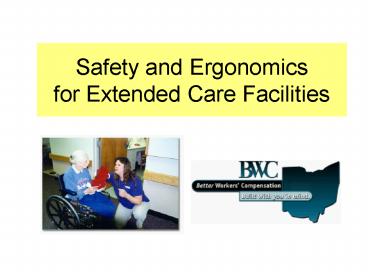Safety and Ergonomics for Extended Care Facilities PowerPoint PPT Presentation
1 / 25
Title: Safety and Ergonomics for Extended Care Facilities
1
Safety and Ergonomics for Extended Care
Facilities
2
Course Development Team
- Mike Rienerth, Ergonomics Consultant, BWC
- Mike Donohue, Safety Consultant, BWC
- Greg Nartker, Ergonomics Consultant, BWC
- George Kunz, Safety Consultant, BWC
- Rick Hughes, Manager of Occupational Safety
Health, Ohio Masonic Homes - Mel Tobias, Safety Compliance Manager, Sprenger
Retirement Centers - Marty Grant, Curriculum Designer, BWC
3
BWC - Safety Hygiene Services
- Consultative services to assist with safety,
ergonomics, and occupational health issues - Already paid for through WC premiums
- Nonregulatory no enforcement power
- No reporting to enforcement agencies
4
Definition
- Extended-care facilities include
- Nursing homes
- Mental health facilities
- Full-time care facilities
- Long-term care facilities
- Other?
5
COURSE OBJECTIVES
- Gain a better appreciation for the benefits of an
effective safety health process - Learn about tools and resources that can be used
to enhance safety management systems - Review common OSHA compliance requirements for
extended care facilities
6
COURSE OBJECTIVES
- Learn about tools and resources that can be used
to assist with OSHA compliance - Review common ergonomic issues and control
measures for extended care facilities - Discuss management strategies that can assist in
the implementation of safety and ergonomics
improvements
7
What are your objectives?
- Introduce yourself
- Name
- Occupation
- Facility
- Mention one of your objectives for attending this
course
8
Key Questions
- Who is responsible for safety at your facility?
- Who is accountable for safety performance at your
facility?
9
Regulatory Compliance
- Ohio Department of Health (ODH)
- Resident safety
- Joint Commission for Accreditation of Health
Organizations (JCAHO) - Resident safety
- Occupational Safety Health Administration
(OSHA) - Staff safety
10
OSHA 5(a)(1) General Duty Clause
- 1970 OSH Act
- Each employer shall furnish a workplace free of
recognized hazards
11
OSHA Recordable Injury/Illness Incidence Rates
12
What is Your Facilitys OSHA Recordable Incidence
Rate?
- IR of OSHA Recordables x 200,000 of
exposure hours (hrs. worked) - The IR represents the number of OSHA recordable
injuries/illnesses per 100 full time workers over
a given period of time
13
Days Away, Restricted and/or Transferred (DART
Rate) (BLS)
14
Estimate your Experience
Type of injury Your percentage Possible Causes
Overexertion
Slips/Falls
Contact with
Struck by
Caught in/on or between
15
Types of Injuries in EC Facilities
16
Money Matters
- What does your facility currently pay?
- Workers compensation coverage
- Healthcare insurance
- Liability insurance
- Property insurance
- Other
17
What are the Costs of an Ineffective Safety
Process?
- The average cost for a medical only injury in
Ohio is 800 - The average cost for a lost-time injury in Ohio
is 44,000 (medical indemnity reserves) - Average workers comp premiums for a base rated
100-bed facility are about 160,000/year - Average workers comp premiums for a group rated
100-bed facility are about 80,000/year
18
Average Annual Workers Comp Premiums for EC
Facilities
Experience Modifier (EM)
19
Employer Rating Plan History
Payroll period beginning date Payroll period ending date Experience rate Employer rating plan
7/1/2004 12/31/2004 44 GROUP
7/1/2003 12/31/2003 57 GROUP
7/1/2002 12/31/2002 82 EXP
7/1/2001 12/31/2001 110 EXP
7/1/2000 12/31/2000 127 EXP
7/1/1999 12/31/1999 143 EXP
7/1/1998 12/31/1998 172 EXP
7/1/1997 12/31/1997 220 EXP
20
What are Some Other Costs of an Ineffective
Safety Process?
- 10 to 20 of people leave the nursing profession
due to injury - Average turnover rate of STNAs in nursing homes
is 50-60 - Average cost to recruit, hire, and train a STNA
2,000 - 3,000 - The average cost of OSHA citations for HC
facilities is approximately 10,000 to 15,000
per inspection
21
Iceberg AnalogyAccident Cost
Direct Costs
- Medical Payments
- Compensation
Breaking in substitute
Temporary workers
Poor efficiency due to break-up of crew
Indirect or Hidden Costs
Loss of good will
Supervisor time to investigate
Damaged equipment
Overtime by employees
Administrative costs
Change in WC rating
Lost time by fellow workers
22
What motivates safety activities in your facility?
23
Safety Ergonomics ProcessThe Benefits
- Compliance and hazard prevention
- Reduced injuries and lost time
- Lower worker compensation costs
- Lower absenteeism and turnover
- Better employee relations and morale
- Better Quality Care!
24
Strengths and Weaknesses
- What is one thing that your facility does well to
ensure staff safety? - What is one thing that you feel your facility
needs to address to improve staff safety?
25
Elements of an Effective Safety Ergonomics
Process
- Management Commitment
- Employee Involvement
- Accountability
- Documentation
- Integration
- Communication
- Monitoring/Evaluation
- Flexibility
- Continuous Improvement

